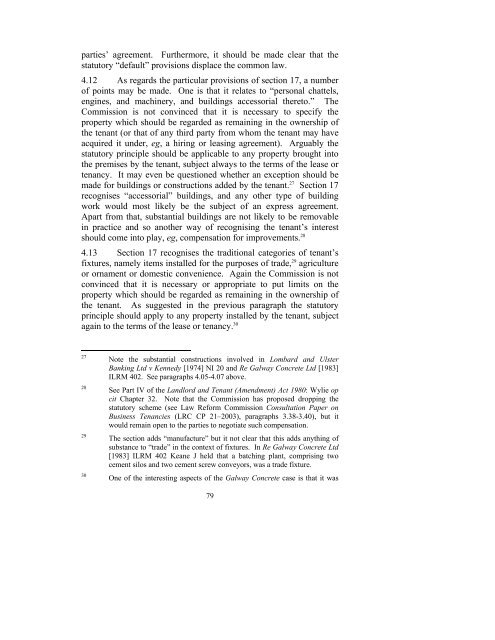Consultation Paper on the General Law of the Landlord and Tenant
Consultation Paper on the General Law of the Landlord and Tenant
Consultation Paper on the General Law of the Landlord and Tenant
You also want an ePaper? Increase the reach of your titles
YUMPU automatically turns print PDFs into web optimized ePapers that Google loves.
parties’ agreement. Fur<strong>the</strong>rmore, it should be made clear that <strong>the</strong>statutory “default” provisi<strong>on</strong>s displace <strong>the</strong> comm<strong>on</strong> law.4.12 As regards <strong>the</strong> particular provisi<strong>on</strong>s <strong>of</strong> secti<strong>on</strong> 17, a number<strong>of</strong> points may be made. One is that it relates to “pers<strong>on</strong>al chattels,engines, <strong>and</strong> machinery, <strong>and</strong> buildings accessorial <strong>the</strong>reto.” TheCommissi<strong>on</strong> is not c<strong>on</strong>vinced that it is necessary to specify <strong>the</strong>property which should be regarded as remaining in <strong>the</strong> ownership <strong>of</strong><strong>the</strong> tenant (or that <strong>of</strong> any third party from whom <strong>the</strong> tenant may haveacquired it under, eg, a hiring or leasing agreement). Arguably <strong>the</strong>statutory principle should be applicable to any property brought into<strong>the</strong> premises by <strong>the</strong> tenant, subject always to <strong>the</strong> terms <strong>of</strong> <strong>the</strong> lease ortenancy. It may even be questi<strong>on</strong>ed whe<strong>the</strong>r an excepti<strong>on</strong> should bemade for buildings or c<strong>on</strong>structi<strong>on</strong>s added by <strong>the</strong> tenant. 27 Secti<strong>on</strong> 17recognises “accessorial” buildings, <strong>and</strong> any o<strong>the</strong>r type <strong>of</strong> buildingwork would most likely be <strong>the</strong> subject <strong>of</strong> an express agreement.Apart from that, substantial buildings are not likely to be removablein practice <strong>and</strong> so ano<strong>the</strong>r way <strong>of</strong> recognising <strong>the</strong> tenant’s interestshould come into play, eg, compensati<strong>on</strong> for improvements. 284.13 Secti<strong>on</strong> 17 recognises <strong>the</strong> traditi<strong>on</strong>al categories <strong>of</strong> tenant’sfixtures, namely items installed for <strong>the</strong> purposes <strong>of</strong> trade, 29 agricultureor ornament or domestic c<strong>on</strong>venience. Again <strong>the</strong> Commissi<strong>on</strong> is notc<strong>on</strong>vinced that it is necessary or appropriate to put limits <strong>on</strong> <strong>the</strong>property which should be regarded as remaining in <strong>the</strong> ownership <strong>of</strong><strong>the</strong> tenant. As suggested in <strong>the</strong> previous paragraph <strong>the</strong> statutoryprinciple should apply to any property installed by <strong>the</strong> tenant, subjectagain to <strong>the</strong> terms <strong>of</strong> <strong>the</strong> lease or tenancy. 3027282930Note <strong>the</strong> substantial c<strong>on</strong>structi<strong>on</strong>s involved in Lombard <strong>and</strong> UlsterBanking Ltd v Kennedy [1974] NI 20 <strong>and</strong> Re Galway C<strong>on</strong>crete Ltd [1983]ILRM 402. See paragraphs 4.05-4.07 above.See Part IV <strong>of</strong> <strong>the</strong> <strong>L<strong>and</strong>lord</strong> <strong>and</strong> <strong>Tenant</strong> (Amendment) Act 1980: Wylie opcit Chapter 32. Note that <strong>the</strong> Commissi<strong>on</strong> has proposed dropping <strong>the</strong>statutory scheme (see <strong>Law</strong> Reform Commissi<strong>on</strong> <str<strong>on</strong>g>C<strong>on</strong>sultati<strong>on</strong></str<strong>on</strong>g> <str<strong>on</strong>g>Paper</str<strong>on</strong>g> <strong>on</strong>Business Tenancies (LRC CP 21–2003), paragraphs 3.38-3.40), but itwould remain open to <strong>the</strong> parties to negotiate such compensati<strong>on</strong>.The secti<strong>on</strong> adds “manufacture” but it not clear that this adds anything <strong>of</strong>substance to “trade” in <strong>the</strong> c<strong>on</strong>text <strong>of</strong> fixtures. In Re Galway C<strong>on</strong>crete Ltd[1983] ILRM 402 Keane J held that a batching plant, comprising twocement silos <strong>and</strong> two cement screw c<strong>on</strong>veyors, was a trade fixture.One <strong>of</strong> <strong>the</strong> interesting aspects <strong>of</strong> <strong>the</strong> Galway C<strong>on</strong>crete case is that it was79
















